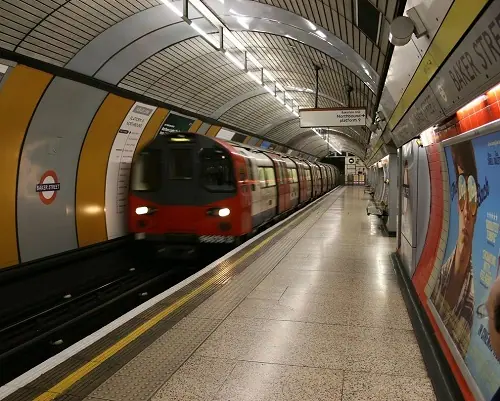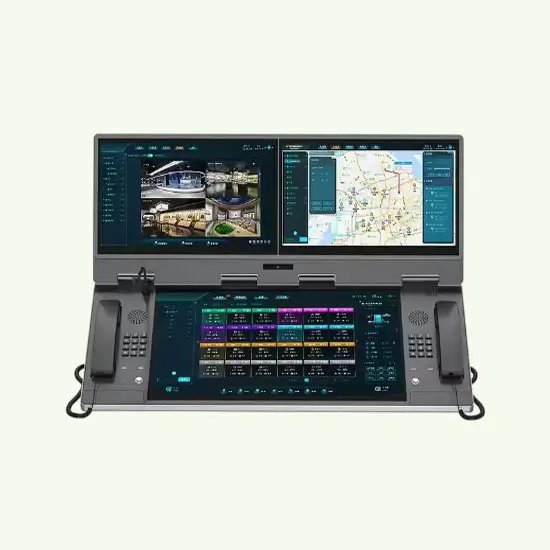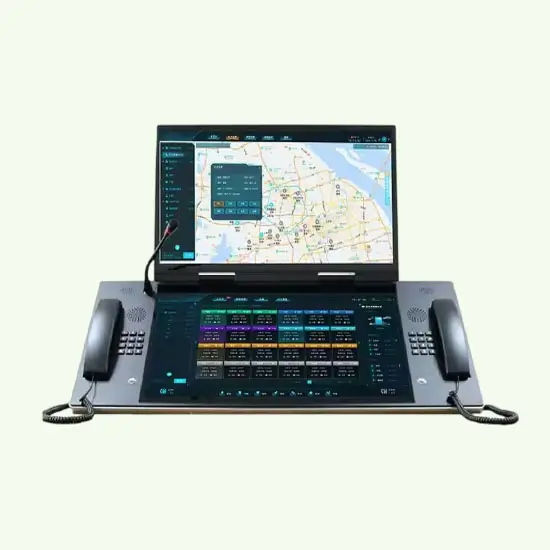OVERVIEW
Metro station intercom system relies on IP network to achieve audio and video communication, integrated emergency alarm, PA system, CCTV and remote management functions, applicable to platforms, station halls, control rooms, entrances and exits and other areas, support multi-point interconnection and centralised management, to ensure that the station communication is highly efficient and safe, and to meet the needs of daily operation, emergency alarm and security management.
KEY Features
Passenger Service Support
Emergency help: IP emergency intercom terminals are installed in metro stations, so that passengers can have a two-way conversation with the metro station control room by triggering a button, and provide real-time feedback on emergency situations (e.g., injuries, illnesses, conflicts).
Special People Assistance: Barrier-free areas are equipped with visual intercom devices that support voice interaction. For example, inside the toilets of the metro station, specifically for the disabled emergency call, configured IP intercom terminal, the disabled encountered an emergency situation, you can ask for help from the metro control room staff. Timely handling of emergencies.
Operation scheduling co-operation
Cross-departmental communication: divide ticketing, station service, maintenance and other exclusive call groups, support single call/group call/broadcast scheduling, a single host can manage multiple devices and IP intercom .
Device Integration: The intercom system is connected with the emergency call system of the ticket vending machines, the elevator emergency call system, the internal emergency call system of the station, and other systems. In case of an emergency, it allows passengers to call the Metro station control room for assistance. The control room staff can view the specific location and live video footage on their computer client or IP Dispatch Console Phone, enabling two-way intercom communication to promptly address any issues passengers may encounter.
Emergency Command
One-Click Alarm: Staff can trigger an emergency call through the pillar terminal with one click, which automatically reports the location to the command center and simultaneously activates video surveillance.
Multi-System Integration: In the event of a fire or terrorist attack, the intercom system links with the broadcasting system, turnstiles, and lighting equipment to broadcast evacuation instructions and open emergency channels.
Solution Topology Diagram

Application
Emergency Assistance at Metro Station Platform:
When passengers encounter emergencies (such as sudden health issues) at the Metro station platform, they can quickly call for help by pressing the one-touch button on the pillar terminal. The control room will respond swiftly. For example, if a passenger feels unwell on the platform, such as dizziness or chest tightness, they can immediately press the one-touch call button on the pillar assistance terminal. The control room will instantly receive the distress signal, and staff will communicate with the passenger via the intercom to understand the situation. Based on the circumstances, medical personnel within the station will be notified to bring emergency equipment to the scene. At the same time, surveillance cameras will be activated to monitor the situation, ensuring that the passenger receives timely and effective assistance, safeguarding their life and safety.
Control Room Dispatch management:
Duty personnel communicate in real-time with various positions through IP Dispatch Console Phone to coordinate operations. During daily Metro station operations, control room staff need to maintain close communication with workers at various positions such as the concourse, platform, and entrances/exits, in order to coordinate and address various operational matters promptly, such as train departures and arrivals, equipment malfunctions, and passenger services. Through the desktop management terminal of the IP intercom system, duty personnel can engage in real-time communication with each position, issue work instructions, understand the situation on-site, and achieve efficient and orderly operational dispatch and command, ensuring the smooth operation of the Metro station.
Entrance and Exit Management:
At entrances and exits without staff, intercom terminals are deployed, allowing passengers to remotely inquire about ticketing or routes. Due to layout or staffing arrangements, some Metro stations may not have personnel stationed at certain entrances and exits. After installing IP intercom terminals at these locations, passengers can remotely communicate with the control room if they encounter ticketing issues (such as card malfunctions, insufficient balance, etc.) or are unfamiliar with the travel routes when entering or exiting the station. Through video footage, staff can check the passenger’s ticket card status or understand the passenger’s specific needs, providing appropriate responses and guidance. This helps solve practical issues for passengers, enhances their travel experience and satisfaction, and reduces service gaps caused by unattended entrances and exits.
Emergency Evacuation:
In the event of a fire or power outage, the control room issues evacuation instructions via the intercom system, linking with the broadcast and monitoring systems. When emergencies such as fire or power failure occur in a Metro station, control room staff quickly use the broadcast function of the IP intercom system to issue emergency evacuation instructions to all areas of the station. They provide important information to passengers, such as the location of evacuation exits, evacuation routes, and correct evacuation methods. At the same time, the monitoring linkage function is activated to monitor the evacuation process in real-time, promptly identifying and addressing issues like congestion or obstructions along evacuation routes. This ensures that passengers can evacuate quickly and safely to secure areas outside the station, minimizing casualties and property damage.
Core equipment
IP Intercom Type
Wall-mounted IP Intercom :
Installed in areas such as station halls, ticket counters, and disabled restrooms, this terminal provides passengers with a convenient way to make inquiries or request emergency assistance in areas where people tend to gather. Its wall-mounted installation saves space and is easy to maintain and manage.
Pillar-type Help Terminal:
Deployed on platforms and emergency passages, this terminal is equipped with a one-button call button. Considering the large area of the platform and frequent movement of passengers, the pillar-type terminal is more visible, offering assistance services to passengers. Especially in emergencies, passengers can quickly locate and use the terminal to request help. The deployment in emergency passages ensures that passengers can receive timely assistance in special situations.
Desktop Management Equipment:
The IP Dispatch Console phone is used in control rooms or dispatch centers, enabling staff to manage daily communications, emergency command and dispatch, as well as interact with other intercom terminals. It is one of the core management devices in the entire IP intercom system.
Features
HD Audio and Video Calls:
Supports full-duplex communication, ensuring clear and smooth interaction between both parties. Whether it’s for passenger inquiries or emergency assistance scenarios, it allows for accurate communication of on-site situations and needs.
One-Button Emergency Assistance:
When passengers press the button, it quickly connects them to the control room or security center, significantly reducing the response time for assistance. This is crucial for handling sudden emergencies and ensuring the timely protection of passenger safety and the normal operation of the Metro station.
Integrated with CCTV:
Supports linkage with CCTV, enabling staff to simultaneously view live video footage while handling calls or communications, providing a more intuitive understanding of the scene, offering strong support for decision-making and command, and enhancing security monitoring capabilities.
Built-in Speaker:
Supports broadcasting announcements or public messages, facilitating the control room in delivering critical information to various areas of the station, such as train schedule adjustments or safety reminders, ensuring passengers receive timely updates and improving the efficiency of operational information dissemination in the metro station.
Feature Highlights
Environmental adaptability:
Equipped with dustproof and waterproof (IP65/IP66) and vibration-resistant features, it can adapt to the complex environmental conditions within Metro stations, such as frequent vibrations on platforms, high dust levels, and occasional moisture. This ensures long-term stable operation of the equipment and reduces the risk of equipment failure due to environmental factors.
Protocol compatibility:
Supports the international standard SIP protocol and is compatible with mainstream IP-PBX or cloud intercom platforms. This provides convenience for the integration of the communication system in Metro stations, enabling seamless connection with existing communication infrastructure. It reduces the cost of system construction and maintenance, while also facilitating future expansion and upgrades.
Power supply convenience:
By adopting the PoE power supply method, the wiring costs and construction difficulty are reduced. In large-scale, multi-area scenarios such as Metro stations, it enables more efficient deployment of equipment. It also facilitates centralized power supply management of the devices, enhancing the system’s reliability and stability.
IP PBX Server
Deployment
Deployment: The IP PBX server can be deployed in the Metro station control room or data center, or it can be deployed in the cloud. Deploying in the control room allows for local management and real-time monitoring, while deployment in the data center provides more powerful data processing and storage capabilities. Cloud deployment offers flexibility and scalability, making it ideal for varying needs and infrastructure of the Metro station. The choice of deployment method should be based on the actual requirements and infrastructure of the Metro station.
Intercom Management:
Responsible for managing the registration, call routing, and permission allocation of all intercom devices, ensuring that each intercom can properly connect to the system and communicate according to predefined rules. Additionally, it involves assigning permissions to terminals based on different areas and functions, ensuring the security and orderliness of communication.
Features
Intercom Management:
Responsible for managing the registration, call routing, and permission allocation of all intercom devices, ensuring that each intercom can properly connect to the system and communicate according to predefined rules. Additionally, it involves assigning permissions to terminals based on different areas and functions, ensuring the security and orderliness of communication.
Recording and Analysis:
Record call logs, help requests, and operation records to provide detailed data support for post-event analysis. By analyzing these data, it is possible to understand the communication situation within the Metro station, the key issues of passenger assistance, and the system’s operational status. This analysis helps provide decision-making support for optimizing operational management and improving service quality.
System Integration:
Support integration with other systems to enable audio and video linkage. In the event of an emergency, the IP intercom system can integrate with CCTV, alarm systems, etc., to automatically trigger corresponding emergency measures, such as activating emergency plans, accessing monitoring footage from relevant areas, and notifying relevant personnel. This enhances emergency response speed and handling efficiency, ensuring the safe operation of the Metro station.
Network Infrastructure
Network Transmission:
Based on the existing fiber optic or Ethernet in Metro stations, supporting gigabit/10-gigabit networks. Utilizing the existing high-speed network infrastructure, it can meet the data transmission needs of IP intercom systems with large capacity, ensuring real-time and stable transmission of audio and video signals. At the same time, the high bandwidth characteristics of gigabit/10-gigabit networks also provide ample network resource guarantees for system expansion and future business growth.
Protocol:
The international standard SIP protocol is adopted to ensure the quality of audio and video transmission. These protocols have widespread applications and mature technical support in the field of IP communication, effectively ensuring the integrity and accuracy of audio and video data during network transmission, reducing issues such as data loss and delay, thereby providing users with a rich calling experience and reliable communication services.
Bandwidth requirements:
Each video intercom requires approximately 1-2 Mbps, while audio intercom requires about 100 Kbps. The clear bandwidth requirements provide a basis for network planning and resource allocation, ensuring that bandwidth resources are reasonably distributed during network design and optimization processes. This helps meet the audio and video transmission quality demands of the IP intercom system in various scenarios, preventing communication quality degradation or system malfunctions due to insufficient bandwidth.
Security:
Supports encrypted transmission (TLS/SRTP) to prevent data leakage. In places like Metro stations where there is a large density of people and a high volume of information flow, the security of communication data is of utmost importance. By adopting encrypted transmission technology, it can effectively protect the confidentiality of data such as call content and help – seeking information, prevent sensitive information from being stolen or tampered with, and ensure the safety of passenger and Metro station operation information.
Management platform
Features
Real-time monitoring and maintenance:
It allows real-time monitoring of the intercom terminal’s status, including online status, call status, device operating status, etc., to promptly identify and address device malfunctions or anomalies. It also supports remote configuration and maintenance, allowing staff to adjust parameters, perform software upgrades, and other operations without having to be on-site, greatly improving the efficiency and convenience of device management while reducing maintenance costs.
Broadcast Management:
Supports zoned broadcasting or station-wide announcements. It can flexibly broadcast to specific areas or the entire station based on different operational needs and scenarios, such as playing train arrival notifications, safety promotion messages, etc., ensuring precise information delivery and improving the effectiveness and relevance of broadcast messages.
System Integration:
It can be linked with access control systems, CCTV, and alarm systems to enhance emergency response efficiency. When an abnormal situation occurs, the management platform can quickly coordinate with relevant systems to enable fast reactions and collaborative handling. For example, if someone illegally enters, the access control system can lock the passage, trigger alarms, and display surveillance footage, while the intercom system can be used to make an announcement to stop the intruder, effectively improving the metro station’s security and emergency response capabilities.
IP Dispatch Console Visualization Interface:
It features a visual operation interface that supports multi-screen display, allowing control room staff to intuitively view system statuses, surveillance footage, terminal information, and more. This setup enables efficient operation and management. The multi-screen display function allows the simultaneous presentation of different area conditions and system data, helping dispatchers comprehensively monitor station dynamics and make timely decisions and commands, thus improving operational management efficiency and accuracy.
System Workflow
Daily Communication
Passengers can call the control room via the IP intercom terminal at the metro platform or hall. The staff answers the call and provides guidance. For example, when passengers inquire about train schedules, transfer routes, or other issues, they can contact the control room through the IP intercom terminal. The staff will provide accurate answers and guidance, ensuring smooth travel for the passengers.
The control room can actively call designated IP intercom terminals or initiate broadcasts to deliver operational information. In the event of situations affecting passenger travel, such as train schedule adjustments or equipment maintenance, the control room can use the IP intercom system to broadcast messages to all terminals within the station, promptly notifying passengers. This helps prevent inconveniences caused by communication gaps and also improves the transparency of metro station operations and passenger satisfaction.
Emergency Call Point Intercom
When a passenger presses the emergency help button on the IP intercom, the system automatically connects to the control room and activates the camera to record the scene. For example, if a passenger suddenly falls ill or encounters danger at the platform, pressing the help button sends an emergency signal to the control room. Simultaneously, the camera on the terminal is activated, allowing staff to visually assess the situation through the video feed, providing a basis for subsequent rescue operations.
The control room responds quickly based on audio and video information, and activates the security or fire systems when necessary. After receiving the emergency request and reviewing the scene footage, the staff can quickly assess the severity and nature of the incident, promptly dispatching security personnel to the scene for handling. In cases of emergencies such as fires, the fire system is activated to perform firefighting and personnel evacuation tasks, maximizing the protection of passengers’ lives and the safety of the metro station’s property.
Emergency broadcast
In the event of emergencies such as fires or overcrowding, the control room issues emergency evacuation instructions through the intercom system. When emergencies like fires or earthquakes occur, the control room can use the broadcast function of the IP intercom system to quickly issue emergency evacuation instructions to various areas within the station, informing passengers of evacuation directions, routes, and important precautions. This helps guide passengers to evacuate the dangerous areas in an orderly and rapid manner, avoiding secondary disasters such as stampedes caused by panic and chaos.
Supports zone-based broadcasting for precise coverage of designated areas. Depending on different emergency situations and evacuation needs, zone-based broadcasting can be implemented for specific areas. For example, broadcasting can be directed to the station hall area affected by a fire and its adjacent areas, ensuring that evacuation instructions are accurately communicated to the passengers who need to evacuate. This enhances the efficiency and safety of the evacuation process, while also avoiding interference with unrelated areas.
Data management
The system records every call, assistance request, and broadcast event, generating reports for operational analysis. By statistically analyzing this data, the metro station’s operations management department can gain insights into the types, frequency, and distribution areas of passenger assistance requests, as well as the frequency, content, and effectiveness of broadcasts. This allows them to identify issues and shortcomings in the operational process, providing data support for optimizing operations and improving service quality. For example, if assistance requests frequently occur in a specific area, adjustments and optimizations may be needed for the facility layout or personnel configuration in that area.
Technical advantages
High reliability:
The IP intercom system is based on network transmission and adopts a redundant design to ensure uninterrupted communication, adapting to the high-load environment of the metro Redundancy measures are implemented in network links, servers, terminals, and other components, such as dual-link backup, server clusters, and terminal hot backup. When a failure occurs in any component, the system can automatically switch to backup devices or links, ensuring continuous communication. This meets the communication needs in metro stations with round-the-clock, high-density foot traffic, providing reliable communication support for the safe operation of the metro stations.
Low latency:
The optimized audio and video encoding (H.264, G.711/G.722) ensures that the call delay is less than 200ms. By adopting advanced audio and video encoding technologies, the system significantly reduces data transmission latency while maintaining audio and video quality, allowing for real-time communication that feels as natural and smooth as face-to-face conversation. This is crucial for emergency command and passenger assistance scenarios within metro stations, ensuring timely transmission and feedback of information, thereby improving work efficiency and emergency response speed.
Easy to expand:
It supports adding new terminals or cross-station networking, making it suitable for the metro network operation. As metro lines continue to extend and expand, the IP intercom system can be easily upgraded and expanded. New terminals can quickly connect to the system, achieving interoperability with existing devices. Additionally, the system supports cross-station networking, enabling communication and collaboration between different metro stations, providing strong support for unified operation management and emergency command of the metro network, and meeting the growing demands of metro transportation development.
Intelligent:
Such as facial recognition and abnormal behavior detection, enhancing security capabilities. Using artificial intelligence technology, the IP intercom system can perform facial recognition of passengers, enabling quick assistance and identity verification. It can also be used for security monitoring, such as tracking and alerting for key individuals. In addition, the abnormal behavior detection feature can automatically identify abnormal behaviors of passengers within the station, such as fighting, falling, or loitering, and promptly issue alerts to notify staff for handling. This effectively enhances the security level of the metro station, ensuring the personal safety of passengers and public safety.
Convenient Maintenance:
Remote diagnostics and firmware upgrades to reduce on-site maintenance costs. The system is equipped with remote diagnostic capabilities, allowing maintenance personnel to remotely diagnose and troubleshoot terminal devices via the management platform, quickly identifying the issue. Additionally, through remote firmware upgrade functionality, the devices can be updated with software and optimized without the need for frequent dispatch of technical staff for on-site maintenance. This greatly saves labor, material, and time costs, improving the efficiency of device maintenance and the system’s availability.
Precautions
Selection suggestions
Wide coverage:
Select the number of terminals according to the scale of the platform to ensure there are no blind spots. When selecting and deploying IP intercom terminals, factors such as the area, shape, and passenger flow of the platform should be fully considered. Reasonably plan the number and installation locations of the terminals to ensure that passengers can easily find the help – seeking terminals throughout the platform area, achieving non – blind – spot communication coverage. This avoids situations where passengers are unable to seek help in a timely manner in case of emergencies due to insufficient terminal numbers or unreasonable layout.
High Compatibility:
Prioritize devices that support PoE power supply and SIP protocol to reduce deployment difficulty. Choosing devices that support PoE power supply can effectively reduce wiring workload and costs, while improving system scalability and flexibility. Devices that support the SIP protocol can better integrate with existing IP communication systems, achieving seamless connection, reducing system integration difficulty and risk, and also facilitating unified management and maintenance in the future.
Network Planning
Bandwidth Guarantee
Ensure that network bandwidth is sufficient to avoid congestion during peak periods. Based on the bandwidth requirements of the IP intercom system, and considering the communication traffic during daily metro operations, the network bandwidth resources should be reasonably planned. This ensures that the system can operate normally during peak passenger flow periods, such as during rush hours or holidays, without issues like lag or delay in audio and video communication due to bandwidth limitations. Methods such as network bandwidth testing and traffic forecasting analysis can be used to accurately assess the required bandwidth capacity and make necessary network upgrades and optimizations.
VLAN Isolation:
Set up VLAN isolation for intercom traffic to enhance security and stability. By using VLAN technology to separate the network traffic of the IP intercom system from that of other business systems, it can effectively prevent security threats such as network viruses and hacker attacks from affecting the IP intercom system. At the same time, it avoids interference between different business systems, ensuring the network transmission quality and stability of the IP intercom system, and ensuring the reliability and security of communication.
Installation Requirements:
Firm and Reliable:
The terminal should be securely fixed to prevent vibrations or human damage. In places like metro stations where there is heavy foot traffic and complex environments, the installation of the IP intercom terminal must be firm and reliable. Appropriate installation methods and fasteners should be used to ensure that the terminal will not loosen, be damaged, or fall off under vibrations from metro trains or collisions with passengers, ensuring the normal lifespan of the equipment and stable communication functionality.
Proper Height:
The height of the pillar terminal should be appropriate (around 1.2 – 1.5 meters) for easy use by different groups of people. Considering the height differences among passengers, especially for children, the elderly, and people with disabilities, the installation height of the pillar-type help terminal should be designed between 1.2 and 1.5 meters. This ensures that most passengers, when standing, can easily reach the help button and communicate with the terminal, reflecting the humanized and barrier-free design principles of the metro station service.
Testing and Maintenance
Stress Testing:
Before deployment, conduct stress testing to simulate peak call volume. Comprehensive stress testing must be performed before the IP intercom system is officially put into operation. This includes simulating extreme scenarios such as multiple simultaneous calls and prolonged conversations during peak passenger flow periods at metro stations. The test should fully verify the system’s performance, stability, and reliability, and promptly identify and resolve potential issues such as insufficient server processing power, network bandwidth bottlenecks, and unstable terminal device performance. This ensures that the system can meet the communication needs of the metro station during actual operation.
Regular Maintenance:
Periodically check the audio and video quality of terminals, and clean the cameras and microphones. A regular maintenance plan should be established, with professional technicians assigned to check and test the IP intercom terminals’ audio and video quality. This ensures clear communication and smooth, uninterrupted video. Additionally, the camera lenses and microphones should be regularly cleaned to remove dust, stains, and other contaminants that may affect audio and video performance. This helps maintain the system in good working condition, providing high-quality communication services for passengers and staff.
special consideration
Metro Environment:
The system must be resistant to electromagnetic interference and comply with EN50155 or EN50121 standards.
In a metro station, various electromagnetic devices, such as train traction systems and communication signal systems, can generate strong electromagnetic interference. Therefore, the IP intercom system must have excellent electromagnetic interference (EMI) resistance to ensure normal operation in such an environment. It should comply with relevant international standards (EN50155 or EN50121) to ensure that communication signals are not disrupted, preventing issues such as call interruptions or degradation in audio and video quality. This will guarantee the reliability and safety of communication in metro stations.
Peak Period Optimization:
Support multiple concurrent calls, with the control room able to prioritize emergency requests.
During peak passenger flow periods in the metro, multiple passengers may simultaneously use the IP intercom terminals for assistance or inquiries. The system should be capable of handling multiple concurrent calls to ensure that multiple call requests can be processed at the same time, avoiding issues such as line congestion or long waiting times. At the same time, the control room should be able to prioritize different types of calls, giving priority to emergency requests, ensuring timely responses in urgent situations, and safeguarding passenger safety and the normal operation of the metro station.
Multilingual Support:
The terminal interface and voice prompts should support both Chinese and English, as well as other local languages, to accommodate foreign passengers.
With the acceleration of internationalization, the number of foreign passengers in metro stations has gradually increased. To better serve foreign passengers, the IP intercom terminal’s interface display and voice prompt functions should support both Chinese and English, as well as other commonly used local languages (such as Japanese, Korean, French, etc., in tourist cities or international metropolises). This will make it easier for foreign passengers to understand and use the system, improving the internationalization of metro station services and enhancing passenger satisfaction. It also demonstrates the city’s friendly image and high-quality public services.
Conclusion
This metro station IP intercom solution aims to create an efficient, reliable, intelligent, and convenient communication system by appropriately configuring core components, optimizing system workflows, leveraging technological advantages, and considering typical application scenarios along with special requirements. The goal is to enhance the metro station’s operational management, emergency response capability, and passenger service quality, ensuring the safety, stability, and efficiency of metro traffic. During actual implementation, the solution can be further refined and adjusted based on factors such as the station’s size, line conditions, passenger flow characteristics, and budget to ensure the scientific, reasonable, and practical nature of the solution, meeting the metro station’s personalized needs.










